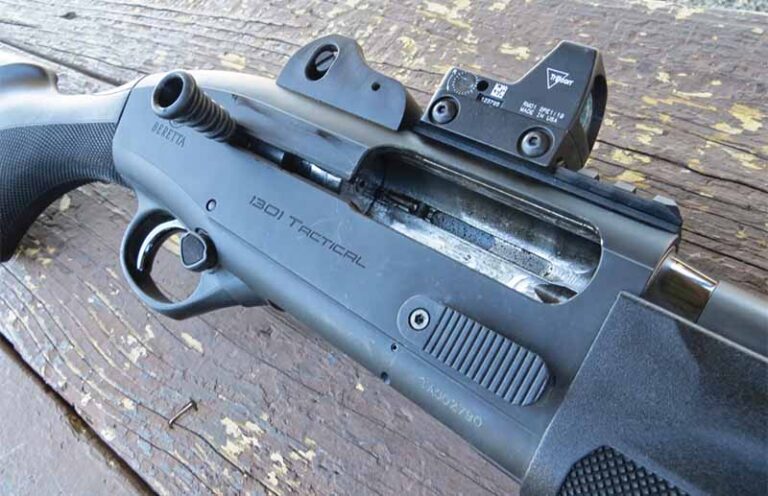
Semi-Auto shotgun makes and models abound. Picking one that will enhance your shooting ability and enjoyment means understanding their operating systems and yourself.
What Are The Best Semi-Auto Shotguns?
- Best For General Hunting: Beretta A400
- Best Waterfowling Shotgun: Benelli Super Black Eagle 3
- Best General Tactical Option: Beretta 1301 Tactical
- Best For Home Defense: IWI TS12
Other Great Semi-Auto Shotgun Options:
The turn of the 20th Century must have been an amazing time to be alive. The advent of the electric light, moving pictures, the internal combustion engine and, of course, the semi-auto shotgun. The mind reels at the technological advancement. Particularly the smoothbore.
Not to take anything away from the horseless carriage and illumination at the flick of a switch, but the autoloading scattergun must have been mind-boggling to the folks of the age. Five shots with little more than the pull of a trigger? The devil you say! Two short decades before 1905, shotguns were exclusively single barrel or side-by-side affairs, complete with external manually cocked hammers. Not exactly the stuff for rapid-fire. Moving to an autoloading system was dang near akin to jumping from ox-and-cart to GTO.
No wonder the semi-auto shotgun dominated much of the past century and only continues to get better with time.
Already know all this stuff? You can JUMP AHEAD to our picks for the best semi-auto shotguns.
Why A Semi-Auto Shotgun
Avoiding the obligatory Why not a semi-auto shotgun? there are some solid logical reasons to consider this type of smoothbore. The two most significant: firepower and ease of use.
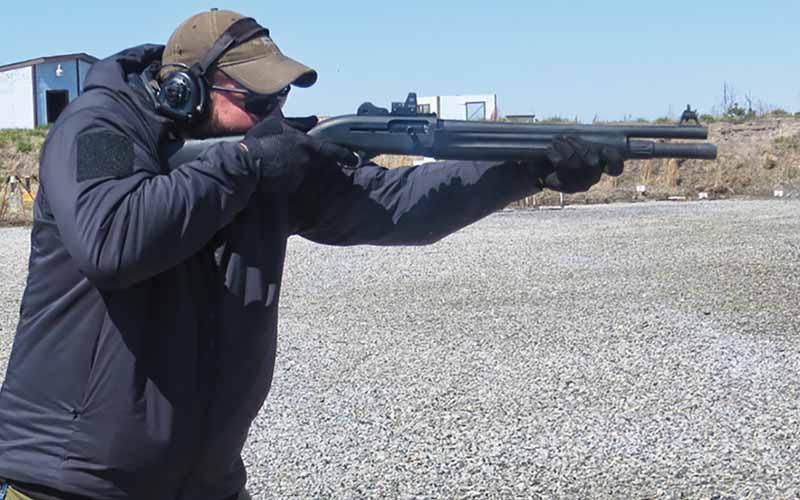
The first is fairly self-explanatory, in most cases, a semi-auto shotgun is capable of delivering more shot downrange in a shorter period of time than anything else. Competitors understand this, with various semi-auto models—such as the Remington Versa Max Competition Pro—dominating 3-Gun Matches. This advantage translates over to any endeavor you might need to send a mass of pellets on target and quick, from knocking down white wings to protecting hearth and home.
As for ease of use, well that too is pretty simple to get a handle on. Once you know how to load a semi-auto shotgun and chamber a shell, the only thing you concern yourself with—barring a malfunction—is aiming and trigger pull. That’s quite a load off the mind—and muscle memory—allowing you to focus on what’s important—hitting the target.
Draw A Bead On Shotguns:
- 9 Affordable Double-Barrel Shotgun Options
- 12 Affordable Pump-Action Shotgun Options
- Lever-Action Shotgun: Past, Present And Future
- Best Over/Under Shotgun: Affordable Doubles
- 5 Best Bullpup Shotgun Options For Compact Defense
Though, don’t confuse ease of use with a less complex system. Compared to its cousins—the double-barrel shotgun and pump-action shotgun—the semi-auto shotgun is most certainly not a simpler machine. Granted, its operational systems—recoil (inertia) or gas, we’ll get to those in a second—aren't beyond the grasp of a well-seasoned novice. But they do involve a bit more understanding to troubleshoot, which means dedication to learning exactly what goes on under the hood.
So, what is going on under there?
Recoil Operated Semi-Auto Shotgun
Now dominated by the inertia system, shotguns that cycle via the kinetic energy from a shot being fired have been with us for some time. The semi-auto alluded to at the beginning that got its start around the time light bulbs were becoming a thing, was recoil-operated. In fact, it was an all-time great—John M. Browning’s Auto-5, which ruled semi-auto shotgun sales for the first 60 years of the last century. Though, its operation was much more complex than what we see today.
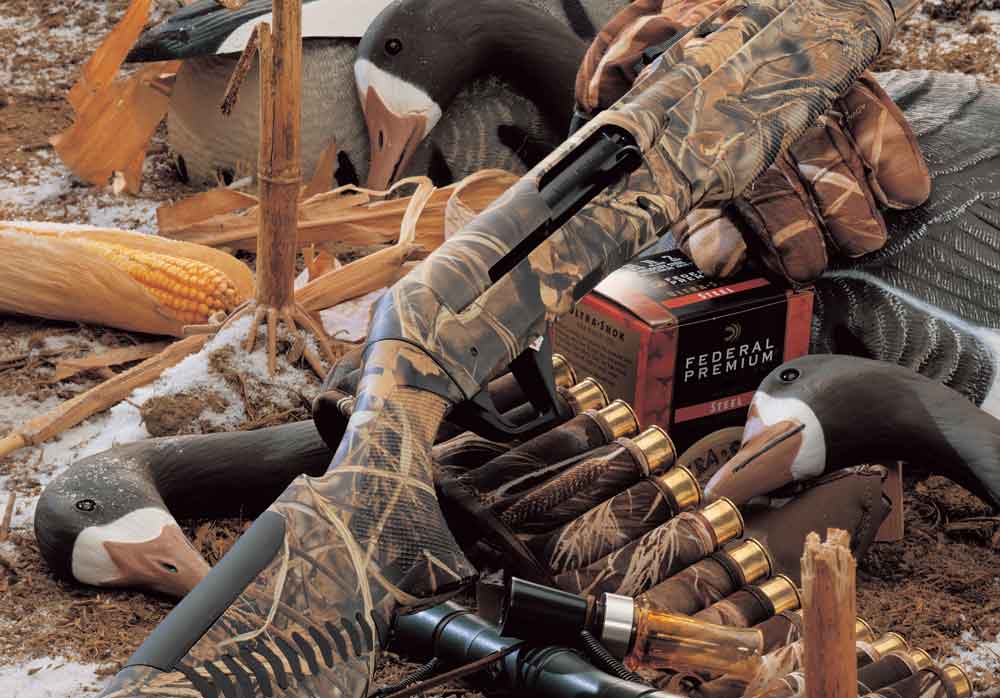
A long-recoil gun, the A-5’s barrel and bolt both moved rearward in unison after a shot, the barrel returning first and ejecting the shell, then the bolt to load a fresh round. After Browning ironed out the initial bugs, the “Humpback” —so-called due to the prominent rear of its action—became renown for its reliability. Replacing the long-recoil semi-auto is a system that draws upon the same force to cycle the gun, but in a slightly different fashion.
In the inertia operated semi-auto shotgun, the bolt carrier and what is known as an inertia spring float freely in the receiver. When fired, the shotgun as a whole recoils rearward, while these components initially retain their position in a state of inertia. The difference in motion compresses the very stiff spring. The force of the spring decompressing unlocks the bolt head, throws the carrier rearward and cycles the gun.
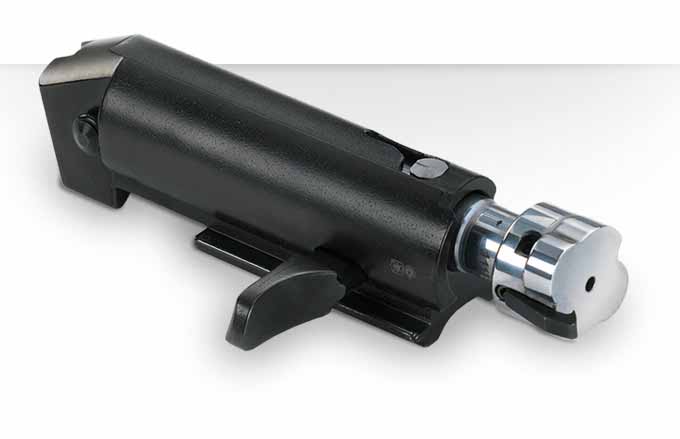
While the system gained popularity with Benelli engineer Bruno Civolani’s improvements of the late 1960s, the system came about soon after Browning’s A-5, developed by Swede Carl Sjögren. The genius of Civolani’s design was its simplification. Sjögren’s system required a separate weight, while the Italian made the bolt carrier the weight. A small detail, but one that gives inertia semi-auto shotguns one of their most favorable attributes—simplicity.
The Benelli proudly boasts its modern inertia operated shotguns only have three moving parts—bolt head, inertia spring and bolt carrier. In turn, they are easy to maintain and tend to stand up to a licking. Waterfowlers love them, given they’ll take all their marshy abuse and still fill a bag.
Inertia guns are also light, which might be good or bad depending on your standpoint. It’s good if you value a nimble field piece you won’t get bogged down carrying all day. The bad of it, light means thump. By and large, the guns generate more felt recoil than gas-operated guns, which can prove problematic for the recoil sensitive and high-volume shooters.
Gas Operated Semi-Auto Shotgun
High Standard was the first to cobble together a gas-operated semi-automatic shotgun in the late 1950s, sold by Sears and marketed under the retailer’s J.C. Higgins brand. But for the most part, the development of the system—especially as we know it today—was a Remington affair. And while it came out with a few models prior—Model 58 for example—Big Green’s Model 1100 set the standard of what became the dominant style autoloader of the latter half of the 20th Century. Reliability of what was considered a finicky system up to that point, along with shootiblity are what etched the 1100 into shooter’s hearts.
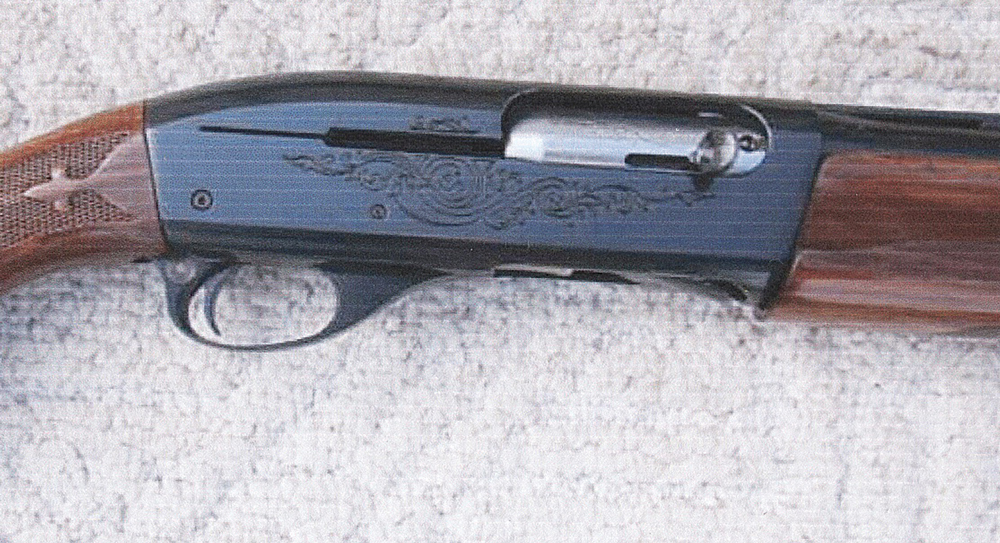
Opposed to recoil, gas-operated shotguns bled off some of the expanding gas of the deflagrated propellent to cycle the gun. The gas drives a piston(s) reward with it the action bars that subsequently operate the bolt. Out with the old, in with the new, hammer cocked and you’re ready to do it all over again. Simple enough, but it is a slightly more complex system that does overall have more components than inertia guns.
Given this, gas-operated semi-auto shotguns tend to be heftier. This aspect is actually a benefit for many, given the weightier firearms soak up more recoil, thus has built a reputation of being easier to shoot. Trap shooters and the like have gravitated to gas guns exactly for this benefit.
Of course, this can make gas guns more burdensome when you’re on the hoof. On top of that, and compared to inertia guns, they're dirty. Even if it isn’t the poop where it eats AR rifle situation, gas-operated semi-auto shotguns require regular cleanings, lest carbon fouling, well … fouls everything up.

This style of semi-auto shotgun, in the past, has also proven difficult to run a wide spectrum of shells through reliably. While most will kick high brass out like it’s late on its bar tab, low brass often doesn’t have enough oomph to cycle. This has changed in recent years with Remington’s Versa Max and V3, and Savage‘s Renagauge shotguns. Each is designed cycle shells with no gas adjustment, no matter the load. Remington does this through numerous ports and Savage values.
Gas Vs Inertia: Which Wins Out?
The correct answer is both. Honestly, if you buy a reputable brand, which there are many nowadays, you’ll get a semi-auto shotgun that will run like a top. What you have to decide is, given the strengths and weaknesses of each operating system, which fits you best as a shooter?
If you shoot mountains of clays each month and want to stay sharp first shot to last, the slightly milder gas-operated semi-auto might be your cup of tea. If you head into the depths of flooded timber for duck season and need a gun that will function no matter if you drop it into a mud hole, well the inertia system will most likely shine for you. Be honest with yourself about your endeavors and you’re personal preferences as a shooter and the right choice should standout.
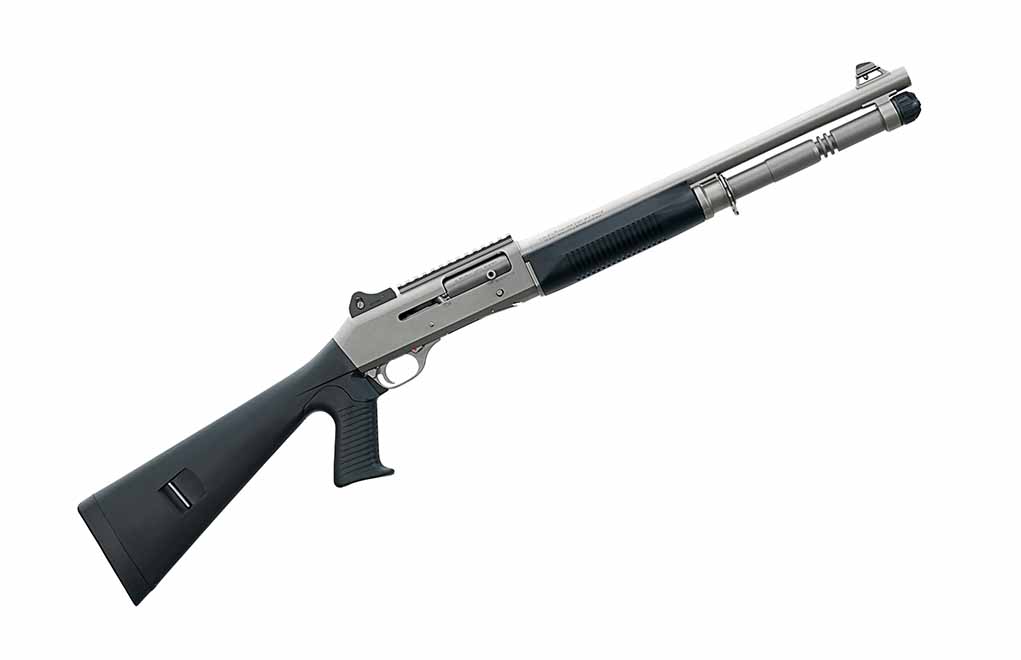
The same holds for self-defense. Overall, both gas- and inertia-operated shotguns are more than capable of holding their own as defensive guns. And there are many fine examples of each with a tactical bent, from Stoeger’s inertia-driven M3000 series to Mossberg’s gas-operated 930 Tactical options, among many others. You just need to figure out what will enhance your shooting and not hinder your training.
Our Selection Process
So, what's our criteria for determining the best semi-auto shotguns? It boils down to personal experience with the guns and our team’s hours behind autoloaders. We’ve weighed the guns on a number of factors, some of the most important being:
- Overall reliability
- Quality of manufacturing
- Shootability
- Aesthetics
Semi-Auto Shotguns Buyer's Guide
Beretta A400
Used by plenty of competition shooters and hunters, Beretta’s semi-auto shotguns are well respected. The A400 series has more to offer than reliability, however. Equipped with Beretta’s Kick-Off hydraulic dampener recoil reduction system and the Blink gas operating system, each A400 is also fast-cycling and easy on the shoulder. This makes follow-up shots in the field as easy as can be. The controls are also enlarged for easier operation, especially while wearing gloves.
Beretta has several different A400 models available with varying barrel lengths, gauges, stock styles and other features to choose from, each geared toward a specific shooting discipline. Regardless of whether you’re after deer, birds or clays, there’s a Beretta A400 out there that could serve you well.
MSRP: Starts at $1,849 // beretta.com
Benelli Super Black Eagle 3
Benelli needs no introduction, as the company’s shotguns are widely regarded as some of the best in the world, regardless of the application. When it comes to waterfowl hunting, however, it’s the Super Black Eagle 3 that takes the cake. It uses a gas-less Inertia Driven System action, similar to the above-mentioned CZ 1012, but Benelli claims that its shotguns have been known to fire over 500,000 rounds without a malfunction. This system also enables reliable function with everything from weak target loads to 3.5-inch magnum shells.
Available in both right- and left-handed configurations, the Super Black Eagle 3 has several features designed to aid with usability and ergonomics. The Comfort Tech 3 stock has shock-absorbing inserts to reduce felt recoil on the shoulder and face, the controls are oversized for faster and easier use and a new loading mechanism makes reloads fast and smooth. It’s available in 12-, 20- and 28-gauge configurations with varying chamber sizes, with a 24-, 26- or 28-inch barrel and with several finish colors and patterns.
MSRP: Starts at $2,199 // benelliusa.com
Beretta 1301 Tactical
Another great semi-auto shotgun option from Italy, the Beretta 1301 Tac is the more tactical cousin of the A400 featured in the hunting shotgun section. Like the A400, the 1301 features Beretta’s BLINK gas operating system, allowing for a 36-percent faster cyclic rate than similar designs. This system allows for reliable operation with a variety of shell types as well.
Other tactical features include a 7+1 capacity when using 2.75-inch shells (though it functions with 3-inch shells as well), ghost ring sights with a Picatinny rail for optics and enlarged, highly textured controls. It also has provisions for mounting a light or laser on the forend. Two models are available, one with a pistol grip and one with a traditional stock, but both feature an 18.5-inch barrel and black synthetic furniture.
MSRP: Starts at $1,720 // beretta.com
IWI TS12
Like the KS-12, the IWI TS12 is another model that excels at on-board ammunition capacity, but it comes at the cost of reload times and bulk. This bullpup semi-auto 12-gauge shotgun holds 15+1 rounds on tap between three rotating tube magazines, but reloading those tubes in a hurry will be much more challenging than swapping box mags.
Despite being so large and bulky, the TS12 weighs only 8 pounds unloaded thanks to its polymer chassis. Its 28-inch overall length keeps it surprisingly compact as well. Another benefit for the tactically-minded is the inclusion of M-LOK rails as standard on the handguard. It’s available in three different finish colors too.
MSRP: $1,399 // iwi.us
CZ-USA 1012
The biggest appeal of the CZ-USA 1012 semi-auto shotgun line is its gas-less inertia operating system, as it makes for some supremely reliable firearms. The system not only allows for the reliable cycling of a wide variety of shells (from low-power birdshot to hot 3-inch magnums), but it also increases the durability of the system and eliminates the need for regular cleaning. During testing, CZ-USA put 5,000 rounds through a 1012 without any maintenance and experienced zero malfunctions and no broken parts during that time. This means that for the average shotgun user, a CZ-USA 1012 will always be ready for the task at hand regardless of how infrequently it’s been cleaned or oiled.
The standard CZ-USA 1012 comes with handsome walnut furniture and a black metal finish that is available with both 28-inch and 26-inch barrel lengths, as well as two different metal finish colors with 28-inch barrels. Synthetic stock models with camouflage finishes are available too.
MSRP: Starts at $679 // cz-usa.com
Browning A5
The Browning A5 is the OG semi-auto shotgun, and it will never go out of style. While its features might not stand up next to some more modern offerings, just like Browning’s 1911, it’s a truly good-enough design to still be perfectly functional over 100 years after its invention. Whether you pick up an older model made by Browning or FN or a new production Browning with their new Kinematic Drive System, an A5 will serve you well. The new-production models feature some improvements, however, so we’ll look more closely at that.
Besides being available with synthetic stocks in various camo patterns and coming with fiber optic front sights, the new Browning A5s also feature the Kinematic Drive System which Browning claims to be extremely reliable, fast-cycling and soft-shooting. Browning’s confidence in the system is backed by a 100,00-round/five-year warranty. Several models are available with different barrel lengths, chamber sizes, stock materials and finishes.
MSRP: Starts at $1,539.99 // browning.com
Benelli M4
Benelli graces this list again, only this time on the tactical side. The Benelli M4 has been considered by many to be the gold standard of tactical semi-auto shotguns since it was first introduced in the late 1990s. This shotgun was designed in accordance with U.S. Army specifications for a new 12-gauge semi-automatic shotgun, and it’s been in military service around the globe ever since.
The main appeal of the Benelli M4 is also the system that warranted its adoption by U.S. Marines—the ARGO (Auto Regulating Gas Operated) system. The system runs much cleaner than most gas-operated weapons, improving reliability in all environments and increasing the possible round count between cleanings. These guns have been known to be run long and hard in very harsh conditions only to keep on ticking. Benelli offers the M4 with a couple of different stock, sight and finish options, but all come with an 18.5-inch barrel and a 12-gauge chambering. While the M4 has become a timeless classic, it comes with a hefty price tag, and its 5-shot tube makes it a bit less tactical than some of the other tactical semi-auto shotguns available today.
MSRP: Starts at $2,299 // benelliusa.com
KUSA KS-12
The Kalashnikov system has been a good fit for semi-auto shotguns ever since the concept was first fielded in Russia in the 1990s as the Saiga-12. Saigas and VEPRs in 12-gauge, 20-gauge and .410 were imported into the U.S. in large numbers until they were cut off by import bans, but in that time they established themselves as an excellent and reliable semi-auto shotgun system.
While Russian-made examples are no longer available new, the concept is still on the market in the form of American- and Chinese-made clones. Of these choices, the KS-12 from Kalashnikov USA is the best. Each KS-12 comes with black synthetic furniture, although models with side-folding stocks and tactical rails are available as well. All the barrels are threaded to accept 12-gauge muzzle brakes, and they’re compatible with most Saiga-pattern accessories. Arguably the most tactical feature of the KS-12, and one that makes it stand out from many other models on this list, is its ability to feed from detachable box magazines. It comes with a 5-round as standard, but KUSA makes 10-rounders too and aftermarket Saiga drums are still available as well. When it comes to fast reloads and having a lot of ammunition on deck, the KS-12 wins.
MSRP: $1,066 // kalashnikov-usa.com
Mossberg 930 SPX Pistol Grip
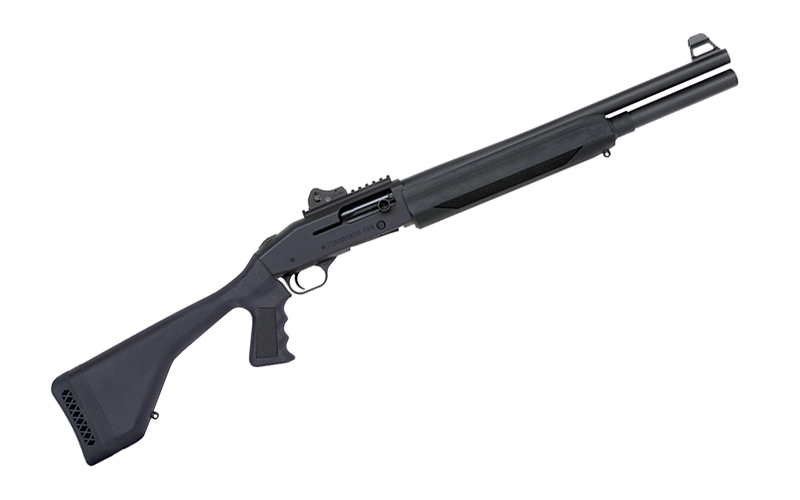
While Mossberg is best-known for its pump-actions, we think that the company’s tactical semi-auto shotguns are worth a look too. Namely, the 930 series. Based on a dual gas-vent system, Mossberg promises the 930 to be reliable, durable and smooth-cycling.
Mossberg has a more traditional Slugster model available as well, but the 930 SPX Pistol Grip comes with black synthetic furniture with a pistol grip, an 18.5-inch barrel, ghost ring/fiber optic iron sights and a Picatinny rail for optics. It features a 7+1 capacity, a 3-inch chamber and an ambidextrous safety, plus a button for quickly unloading the tube. It's available with either a black or tan finish.
MSRP: $1,191 // mossberg.com
Editor's Note: Adam Borisenko contributed to this article.

Next Step: Get your FREE Printable Target Pack
Enhance your shooting precision with our 62 MOA Targets, perfect for rifles and handguns. Crafted in collaboration with Storm Tactical for accuracy and versatility.
Subscribe to the Gun Digest email newsletter and get your downloadable target pack sent straight to your inbox. Stay updated with the latest firearms info in the industry.

![Best Concealed Carry Guns In 2025 [Field Tested] Wilson Combat EDC X9S 1](https://gundigest.com/wp-content/uploads/Wilson-Combat-EDC-X9S-1-324x160.jpg)


![Best 9mm Carbine: Affordable PCCs [Tested] Ruger Carbine Shooting](https://gundigest.com/wp-content/uploads/Ruger-Carbine-Shooting-100x70.jpg)
![Best AR-15: Top Options Available Today [Field Tested] Harrington and Richardson PSA XM177E2 feature](https://gundigest.com/wp-content/uploads/Harrington-and-Richardson-PSA-XM177E2-feature-100x70.jpg)

very comjprehensive. I’d like to see comparison reviews of older shotguns